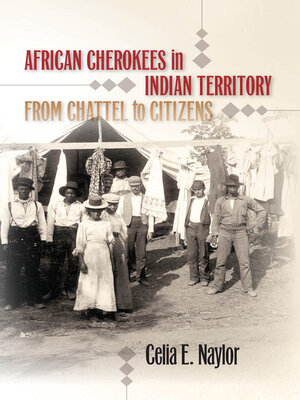African Cherokees in Indian Territory
ebook ∣ From Chattel to Citizens · The John Hope Franklin Series in African American History and Culture
By Celia E. Naylor

Sign up to save your library
With an OverDrive account, you can save your favorite libraries for at-a-glance information about availability. Find out more about OverDrive accounts.
Find this title in Libby, the library reading app by OverDrive.



Search for a digital library with this title
Title found at these libraries:
| Library Name | Distance |
|---|---|
| Loading... |
Forcibly removed from their homes in the late 1830s, Cherokee, Creek, Choctaw, and Chickasaw Indians brought their African-descended slaves with them along the Trail of Tears and resettled in Indian Territory, present-day Oklahoma. Celia E. Naylor vividly charts the experiences of enslaved and free African Cherokees from the Trail of Tears to Oklahoma’s entry into the Union in 1907. Carefully extracting the voices of former slaves from interviews and mining a range of sources in Oklahoma, she creates an engaging narrative of the composite lives of African Cherokees. Naylor explores how slaves connected with Indian communities not only through Indian customs — language, clothing, and food — but also through bonds of kinship.
Examining this intricate and emotionally charged history, Naylor demonstrates that the “red over black” relationship was no more benign than “white over black.” She presents new angles to traditional understandings of slave resistance and counters previous romanticized ideas of slavery in the Cherokee Nation. She also challenges contemporary racial and cultural conceptions of African-descended people in the United States. Naylor reveals how black Cherokee identities evolved reflecting complex notions about race, culture, “blood,” kinship, and nationality. Indeed, Cherokee freedpeople’s struggle for recognition and equal rights that began in the nineteenth century continues even today in Oklahoma.
Examining this intricate and emotionally charged history, Naylor demonstrates that the “red over black” relationship was no more benign than “white over black.” She presents new angles to traditional understandings of slave resistance and counters previous romanticized ideas of slavery in the Cherokee Nation. She also challenges contemporary racial and cultural conceptions of African-descended people in the United States. Naylor reveals how black Cherokee identities evolved reflecting complex notions about race, culture, “blood,” kinship, and nationality. Indeed, Cherokee freedpeople’s struggle for recognition and equal rights that began in the nineteenth century continues even today in Oklahoma.







